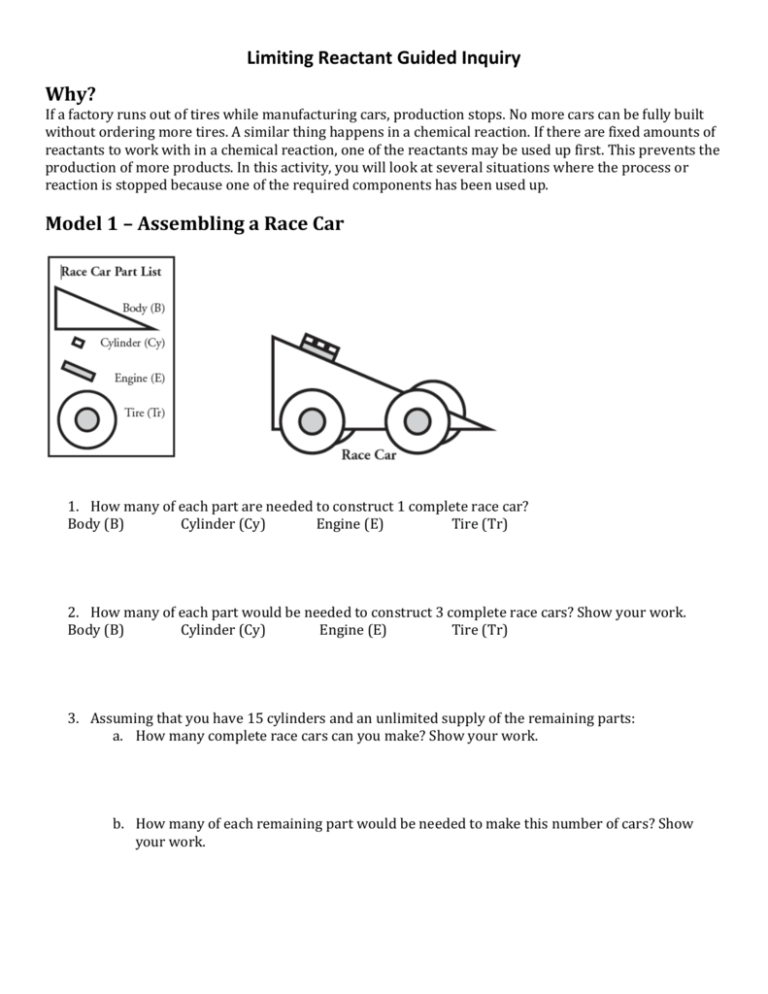File - Ms. Gordon's online classroom
advertisement

Limiting Reactant Guided Inquiry Why? If a factory runs out of tires while manufacturing cars, production stops. No more cars can be fully built without ordering more tires. A similar thing happens in a chemical reaction. If there are fixed amounts of reactants to work with in a chemical reaction, one of the reactants may be used up first. This prevents the production of more products. In this activity, you will look at several situations where the process or reaction is stopped because one of the required components has been used up. Model 1 – Assembling a Race Car 1. How many of each part are needed to construct 1 complete race car? Body (B) Cylinder (Cy) Engine (E) Tire (Tr) 2. How many of each part would be needed to construct 3 complete race cars? Show your work. Body (B) Cylinder (Cy) Engine (E) Tire (Tr) 3. Assuming that you have 15 cylinders and an unlimited supply of the remaining parts: a. How many complete race cars can you make? Show your work. b. How many of each remaining part would be needed to make this number of cars? Show your work. Model 2 – Manufacturing Race Cars 4. Count the number of each Race Car Part present in Container A of Model 2. Body (B) Cylinder (Cy) Engine (E) Tire (Tr) 5. Complete Model 2 by drawing the maximum number of cars that can be made from the parts in Container A. Show any excess parts remaining also. 6. A student says “I can see that we have three car bodies in Container A, so we should be able to build three complete race cars.” Explain why this student is incorrect in this case. 7. Suppose you have a very large number (dozens or hundreds) of tires and bodies, but you only have 5 engines and 12 cylinders. a. How many complete cars can you build? Show your work. b. Which part (engines or cylinders) limits the number of cars that you can make? Model 3 – Micro Mole Rockets Complete the lab experiment as directed by your teacher. Record your data below then construct a graph of your data. Parts H2 0 1 2 3 4 5 6 Part Relative O2 Loudness 6 5 4 3 2 1 0 8. Write the balanced reaction between hydrogen gas and oxygen gas to produce water. 9. From the balanced reaction, how many mole of hydrogen are needed to react with 1 mole of oxygen? 10. Looking at your data or the class data, does the data support this same conclusion? Did the same mole ratio between hydrogen and oxygen produce the loudest popping noise? Model 4 – Assembling Water Molecules 11. Refer to the chemical reaction in Model 4. a. How many moles of water molecules are produced if one mole of oxygen molecules completely reacts? b. How many moles of hydrogen molecules are needed to react with one mole of oxygen molecules? 12. Complete Model 4 by drawing the maximum moles of water molecules that could be produced from the reactants shown, and draw any remaining moles of reactants in the container after reaction as well. a. Which reactant (oxygen or hydrogen) limited the production of water in Container Q? b. Which reactant (oxygen or hydrogen) was present in excess and remained after the production of water was complete? 13. Below are two examples of mathematical calculations that could be performed to find the limiting reactant for the following question: If a container has 8 moles of hydrogen and 6 moles of oxygen, how many moles of water can be produced? Which substance is the limiting reactant? a. Do both calculations give the same answer to the problem? b. Which method seems “easier,” and why? Making Sense 14. Consider the synthesis of water as shown in Model 3. A container is filled with 10.0 g of H2 and 5.0 g of O2. a. Which reactant (hydrogen or oxygen) is the limiting reactant in this case? Show your work. Hint: Notice that you are given reactant quantities in mass units here, not moles. b. What mass of water can be produced? Show your work. c. Which reactant is present in excess, and what mass of that reactant remains after the reaction is complete? Show your work.






